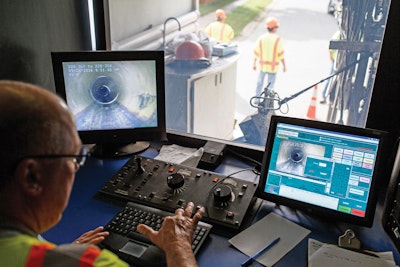
A thorough pre-inspection of pipes selected for replacement or rehabilitation will identify critical items such as pipe lengths, sizes, precise locations, bends or transitions.
Interested in Inspection?
Get Inspection articles, news and videos right in your inbox! Sign up now.
Inspection + Get AlertsNew technology advancements have made cleaning and televising of new and rehabilitated sewer, storm and pressurized pipes safer, more efficient, and cost-effective while providing an added sense of assurance.
Trenchless processes allow for miles of aging pipe to be rehabilitated with less disruption and greater success than ever before, and inspections have become a critical step in these processes. Of course, this applies to new installations and pipe replacement projects as well.
A thorough pre-inspection of pipes selected for replacement or rehabilitation will identify critical items such as pipe lengths, sizes, precise locations, bends or transitions. This information collected from the inspection is often different from the original drawings where information from past projects was not transferred or precise information was simply not available.
A pre-inspection is extremely valuable to the contractor in terms of exact locations for digging, excavating and cutting. The exact location for these services often have an allowable tolerance of less than 2 inches, and the pre-inspection process helps with planning for the next phase of the project. From this inspection, the contractor and owner can better assess the project and assure that proper materials are ordered. All unknown conditions or design changes are identified during this inspection, allowing any needed adjustments to be made early on in the project timeline.
Once the new pipe or liner is installed, cleaning and inspection can provide the contractor and owner assurance that the pipes are free of any debris that may have been collected during the installation process and that the product was properly installed. It also helps identify any issues that may need to be corrected and provides documentation that the project specifications were met to support project closeout, invoicing, payment and historical records. This attention to detail and collaborative effort between the contractor and the owner helps assure work was completed properly and that any issues with the pipe are addressed quickly and safely.
Combination trucks are ideal for cleaning and debris removal both before and after pipe rehabilitation or replacement of pipes 4 inches in diameter or larger. Large volumes of debris must be removed to allow the inspection equipment to move freely through the pipe.
Wheeled or tracked transporters are the proper tools for inspecting these lines. Pan, tilt and zoom capabilities on a color camera with 360-degree head rotation will record any conditions that need to be addressed. Adding a laser profiler will provide more precise measurements and the ability to inspect ovality. Inspection reports are typically generated identifying upstream and downstream manhole numbers, flow direction, manhole depths, pipe size, precise footage and precise location of service lines. These inspection reports also call out any found defects and are inspected using NASSCO Pipeline Assessment and Certification Program standards.
The following are a few key questions to address during a routine post-installation cleaning and inspection:
- Was the pipe installed properly?
- Is it the correct type, size and length?
- Are the pipe joints correct?
- Were joint gaskets installed and installed properly?
- Are there any sags in the pipe?
- Were all tie-ins properly installed?
- Is the pipe clean of all debris?
- Is the pipe ready for acceptance by the owner?
The cleaning and inspection process provides early detection of any unknown conditions or design changes and allows for corrections. Project planning and precise details are collected to help keep the project on schedule and provide assurance and visual documentation that the work performed underground was properly completed, meets the project specifications and can be turned over to the owner without concern.






